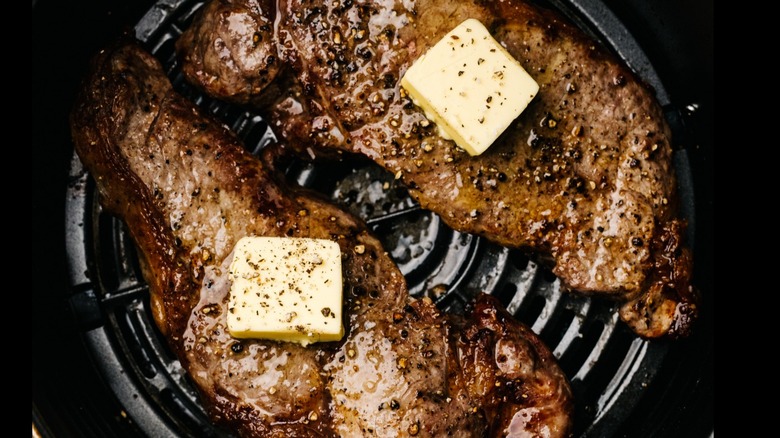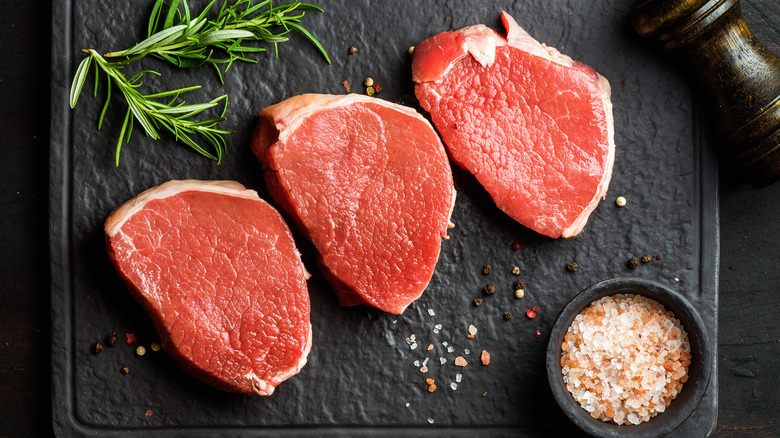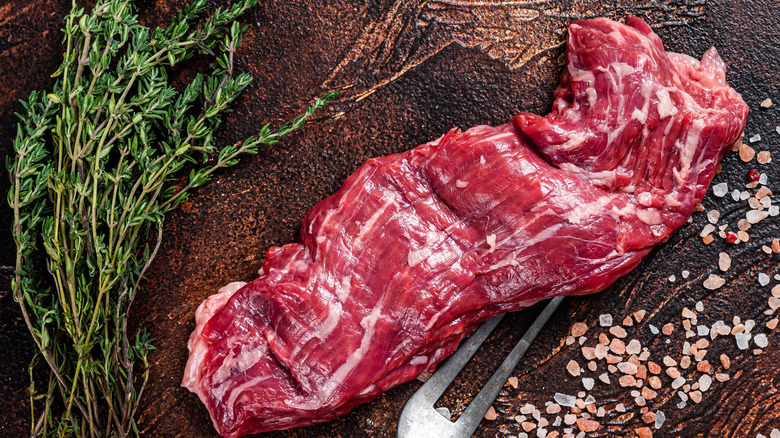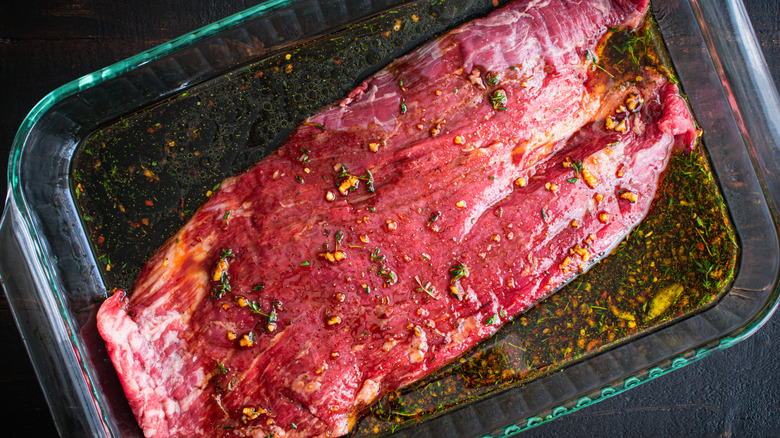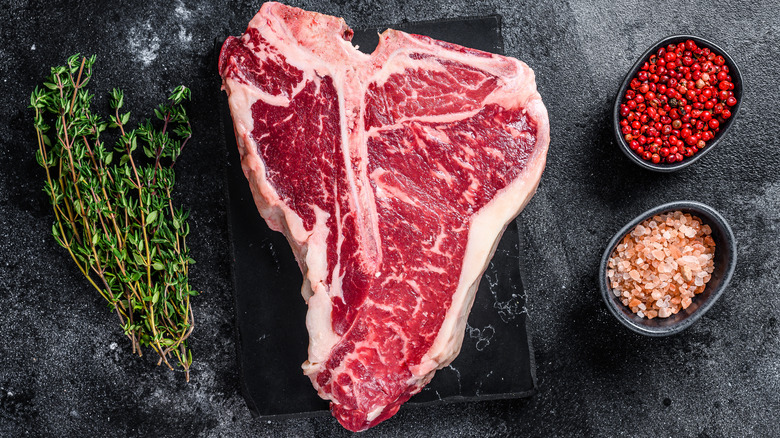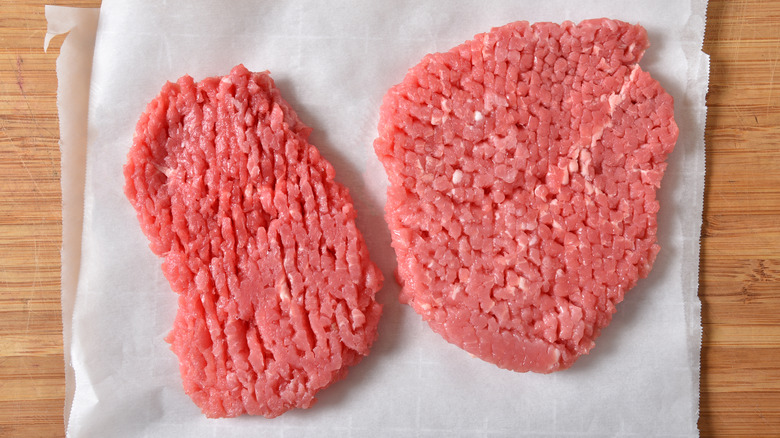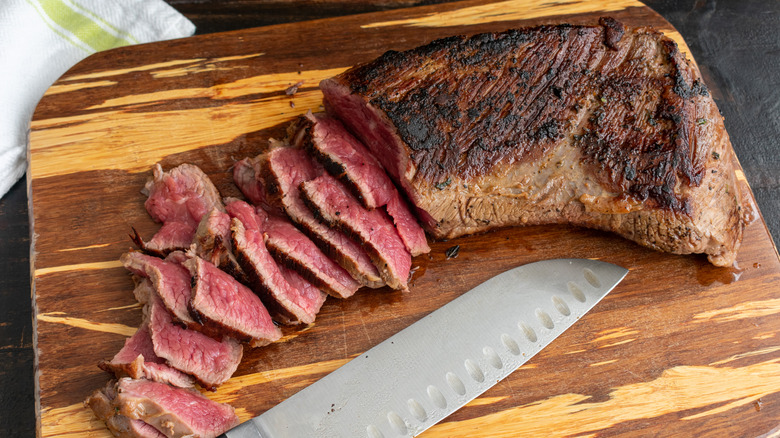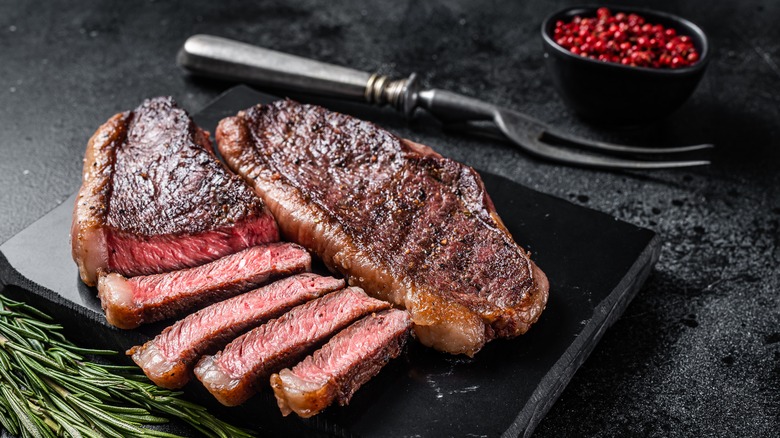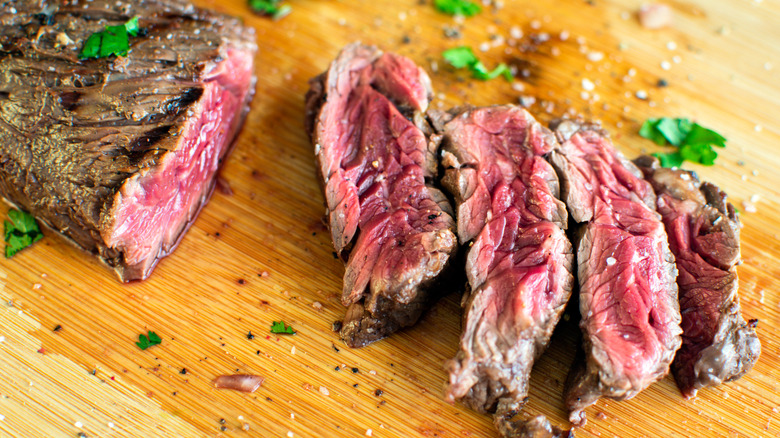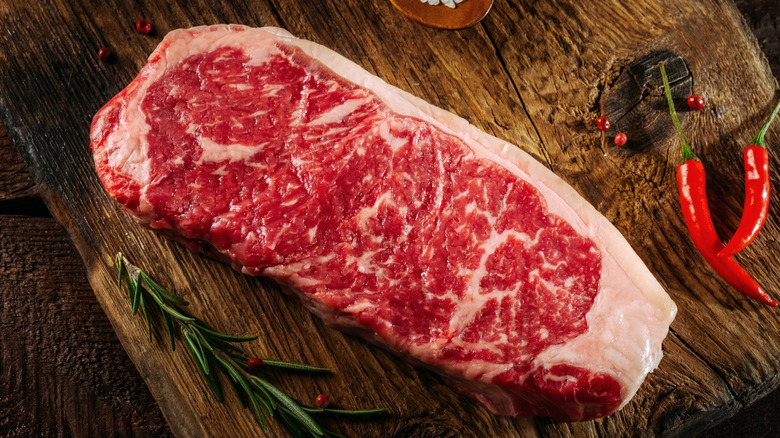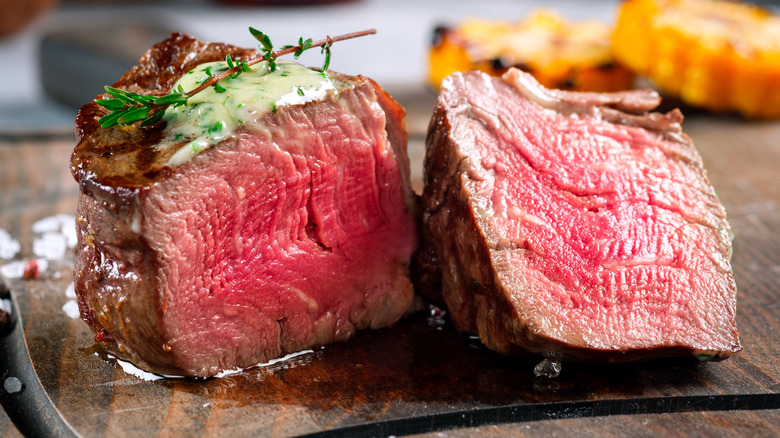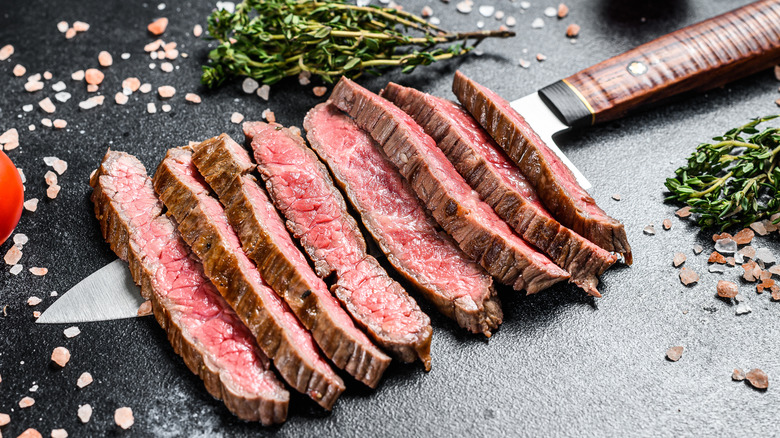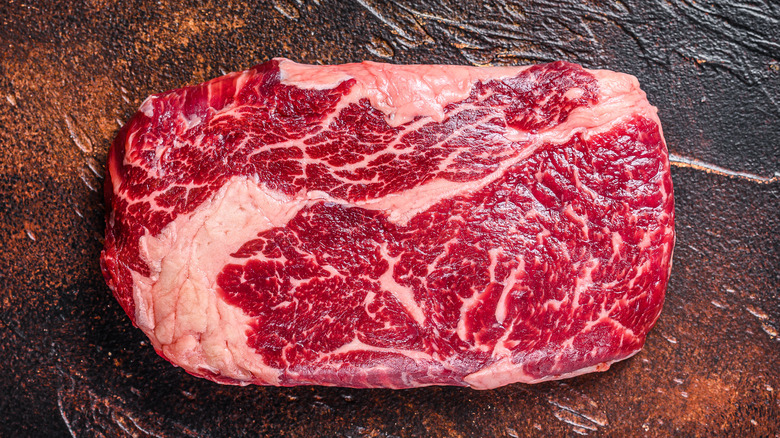The Best Cuts Of Steak To Cook In Your Air Fryer, Ranked From Worst To Best
If the idea of cooking your prized cut of filet mignon in an air fryer gives you pause, you're not alone. It may feel scary to stow your steak in a futuristic convection basket and hope the dry heat does your cut justice. But as Gordon Ramsay has proven with his viral coffee and chili-rubbed ribeye, air fried steak can be done and it can be done well (and by that we mean medium-rare).
Per Insider, there are a surprising number of benefits to cooking steak in an air fryer. You'll avoid the messy splatter and smoke that often accompanies a grilled or pan-seared steak (thanks a lot, ripping-hot cast iron). And the torrid, convective magic that air fryers are known for can help home cooks attain the browned crust and juicy interior so hungrily sought out in steaks — as long as you adhere to these techniques.
But before you run over to your neighborhood butcher (or Aldi's, if you want a bargain), keep in mind that not all cuts of steak are ideal for the air fryer. Below are some of the most famous cuts of steak — from filet mignon and New York strip to the elusive hanger — ranked from worst to best in order of how they perform in the air fryer.
12. Eye of the round
This lean, cheap cut comes from the highly active, muscly rump region of the cow — meaning it's basically starved for fat (not unlike an Olympic swimmer). In fact it's one of the top three leanest cuts of the 17 standard American cuts of beef, averaging 130 calories, 1.2 grams of fat, and 25 grams of protein per 3-ounce serving, according to Beef It's What's For Dinner.
This means that if you're going to coax out some tenderness from this hunk of beef, then the best path forward is with direct grilling, broiling, or a braise. The reason this cut fares so badly in the air fryer (in addition to having zero marbling) is the machine's hot, dry convection. That kind of dry, oil-free environment isn't doing any favors for this already tough and sapless cut. Want to ignore us and try anyway? Then at least promise us you'll marinate.
11. Skirt
This cut has a history of being treated as offal and handed off to field workers, according to Barbecue FAQ. It comes from the diaphragm of a cow and is known for being one of the thinnest cuts around. Not to mention, this budget cut of steak is chock full of muscle fibers, meaning the odds of you getting a satisfying sear in the air fryer before it overcooks are slim to nil.
That's not to say skirt steak is all bad news: it has a reputation of being a wonderful grilled meat, with a powerful, beefy flavor that also shines in fajitas. But with most air fryers maxing out at 400 degrees Fahrenheit, the device is simply not hot enough to accommodate the needs of this tough, narrow cut.
Some folks, like the team at Royal Oak, even opt to cook the skirt "caveman style" directly under coals for an absolute max of two minutes per side, to really achieve a tight sear and rare interior. The nail in the coffin for air fryer skirt steak? The length of the cut. With a length of up to two feet, according to Food Fire Friends, it's an unwieldy shape to negotiate into a small, square basket. If you really must cook this one indoors, try a pan sear or sliced up in a stir-fry.
10. Flank
In terms of air fry-ability, it's a near toss-up between the flank and skirt. Fun fact: both were once so unpopular that they were used mostly as hamburger meat. We ranked the flank slightly higher than its chewy doppelgänger, though, because it's a bit less tough and therefore has a marginally better shot at achieving tenderness with a quick blast in the air fryer (which, to be sure, is still not great odds).
Like skirt, flank steaks require fast and intense heat to achieve a proper sear, something that you're much more likely to accomplish with a grill (or straight-up bed of coals). Moreover, any flank cooked beyond a medium-rare temperature is approaching the overcooked zone, meaning the margin for error is nearly as thin as the cut itself. Still, there is one scenario where an air fried flank steak could make decent sense: for those seeking out a healthy, trim serving of protein with minimal oil.
Texture woes aside, flank steak does offer a nutritious protein to fat ratio in comparison with other cuts like porterhouse or ribeye. And if you're looking to make a quick, no-fuss fajitas dish, you'd do well to follow Every Little Crumb's advice and slice the flank steak into small strips, toss in a zesty marinade, and cook at 390 degrees Fahrenheit for 10 minutes, shaking the basket every so often.
9. Porterhouse
This steakhouse darling is prized for being a "two-for-one" steak cut, with the eponymous "T-bone" serving as the dividing line between a New York strip and tenderloin filet. While technically the terms T-bone and porterhouse are not interchangeable, the recommended cooking technique is essentially the same. The core difference between the two is that the porterhouse, also called "The King of Steaks," is generally more expensive due to it being thicker and containing a higher ratio of tenderloin than the T-bone.
For both cuts, though, it's the composite structure that makes air fry execution so tricky. Since the tenderloin side has less marbling than the strip side, it's recommended to cook them with two different levels of heat. For instance, if you were preparing this cut on a grill, you'd want to switch the steak between a high-heat and low-heat area, as My Chicago Steaks recommends. That's not a feat which can easily be accomplished when you're in a homogenous temperature situation like air frying. So if you're going to dig deep in your pockets for this magnanimous cut of meat, consider firing up the grill or at least the broiler.
8. Cube
No matter what you do, cube steak is going to taste tough (save for serving it chicken-fried and doused in gravy). This deeply affordable cut, also called Swiss steak, is taken from the top or bottom round, i.e, the rump region, and gets its name from the dimpled marks that a mechanical tenderizer leaves on it. The goal of this process is to break down the muscle fibers of this tough cut, rendering it softer and more succulent. As My Chicago Steak explains, a cube steak is basically an elevated version of ground beef. At face value, it may even be difficult to determine the difference: however, cube steak has only been tenderized, as opposed to its beefy look-alike which has ground up and reconstituted into a patty shape.
But hear us out: despite its utter lack of fat and marbling, cube steak actually performs quite well in the air fryer. That's especially true if you follow Air Fryer Eats' example, marinating it for an hour or so ahead of cook time and keeping a close eye on the internal temperature. Sure, a cube steak may not be something you'd want to serve for Valentine's Day or a birthday dinner, but it could certainly pinch hit well for a weeknight supper. And if you decide to make it in the air fryer, your life just got a little bit easier.
7. Tri-tip
The tri-tip, not to be confused with sirloin tip or top sirloin, is a meaty, versatile, and historically under appreciated cut of meat that was popularized in Santa Maria Valley, California in the 1950s. This small, triangular steak gets its name from the location of where it's cut — at the very tip of the sirloin. According to local legend, shares Santa Maria Valley Chamber of Commerce, a butcher named Bob Schutz encouraged Valley residents to consider using this bold cut for more than just hamburgers and stew meat, and over time, tri-tip has increased in popularity and spread through the rest of the country.
And for good reason. The tri-tip boasts a generous amount of flavor and comes out surprisingly tender when seared on a grill or cooked on the highest setting of an air fryer, especially considering it used to be strictly ground up and simmered. However, one thing that can cause trouble is tri-tip steak's trademark, uneven shape. The issue with this, explains Steak School by Stanbroke, is that it means the steak will sometimes cook unevenly. Warning: it can also be challenging to slice this cut against the grain as it contains muscle fibers that run both vertically and horizontally.
6. Top sirloin
Top sirloin is an unfussy weeknight hero. It comes from the top of the cow's subprimal area and is considered to be more tender and flavorful than its counterpart, bottom sirloin. With its robust flavor and versatile composition, it also makes for a solid bet in the air fryer. As Omaha Steaks explains, the top sirloin comes from the upper, more tender portion of the sirloin subprimal. You can think of it as the "poor man's" New York strip, as it's slightly less tender than a "name brand" steak, but still retains a decent amount of fat and marbling (Via Gambrick).
When cooking the top sirloin, this cut benefits from high dry heat, meaning your air fryer should be able to make decent work of it, so long as you take the proper steps to keep it from drying out. If you've got time to spare, Just Cook also recommends salting the steak the night before cooking and letting it chill uncovered in the fridge. This dries out the surface of the steak a bit more and helps make that Maillard reaction really sizzle.
5. Hanger
The hardest part of cooking hanger steak in an air fryer is getting your hands on one of these affordable, yet elusive cuts. Until recently, hanger tended to fly under-the-radar, but now the cat's out of the bag on this surprisingly tender cut, which gets its name from the way it literally hangs, largely undisturbed, between the kidneys. What makes it so special, beyond the fact that it's protected by the rib cage and therefore exceptionally soft, is that each cow makes just one two-pound hanger steak apiece.
All that to say, if you do successfully nab one, do a quick victory dance. As for the cooking process: stay closer to the rare side of things. If you've got time, marinate the meat for a few hours. If you're in a rush, another good option is to cook for a few minutes on each side in the air fryer, then whip up some chimichurri and drizzle that Argentine magic all over your finished product.
4. New York strip
Marbled and tender with intense flavor, the New York strip checks a lot of boxes for steak lovers. Also referred to as a Kansas City strip, the cut is taken from the fairly inactive short loin and is essentially half of a T-bone or porterhouse steak, sans tenderloin. According to Harry And David, there's some debate about whether residents of Kansas City popularized this cut before the famous New York City restaurant Delmonico's put this steak on the menu back in the 1820s — but one thing we do know is that American diners have loved this particular cut of meat for hundreds of years.
Anyway, the absolute best way to prepare this steak is pan-fry method, but it works well enough in the air fryer, too. With an air fryer, it's true that you won't see the beautiful, caramelized crust that us carnivores have come to expect from a heavy-duty cast iron technique — and you may, tragically, see a bit of gray band — but, at least for us, the majority of the steak achieved a rosy medium rare interior without too much fuss.
You'd do well to coat this steak with a simple coating of salt, pepper, and olive oil over the steak before popping it into the air fryer for cooking. Depending on the meat's thickness, five minutes on each side in a 400 degree Fahrenheit basket should do the trick.
3. Filet mignon
Did you know that filet mignon is French for "cute filet"? This petite, boneless filet, known for its mild, buttery flavor, is one of the most expensive, occasionally maligned, yet tender cuts of steak in the game. Taken from the tenderloin of the cow, an area which sees little exercise, this filet is one of the smallest portions of meat available from the cow (making up just 8%). This cut also has minimal connective tissue, meaning it's exceptionally soft — so much so, that when cooked correctly, you barely even need a knife to eat it. Now that's the kind of culinary magic we are here for.
While a filet mignon's length is an ideal fit for the air fryer basket, and the end result can be one of divine succulence, you will want to be mindful of how thick of a cut you select. As food scientist Linda Larsen shared with Insider, anything thicker than two inches may be challenging to cook beyond medium-rare. If you want to give it a go, it's recommend you cook it at 400 degrees Fahrenheit for 11-13 minutes. And do yourself a favor: be sure to baste it with butter, or if you're feeling extra hungry, wrap a strip of bacon around it before tucking it in the air fryer.
2. Flat iron
Much like the hanger, the flat iron steak is one of those cuts that started out affordable and underappreciated and has since seen a wave of popularity, as the Ogeechee Meat Market explains. Per The Fancy Rancher, the steak earned its unique name from a group of University of Nebraska and University of Florida professors, who were part of a project that sought out new approaches to steak that would help lower the waste of beef per cow. The researchers explored thousands of different possibilities and eventually decided that the flat iron, derived from the cow's shoulder, was the best cut of them all.
Once the cut was officially recognized in 2002, they decided that the steak resembled an old fashioned flat iron, and thus its name was born. As for how to prepare it: this steak may be at its best when on the grill, but its generous marbling ensures that it will remain tender, juicy, and full of flavor in the air fryer, too — just be sure not to keep it in there for too long, as once it's cooked past medium, it gets pretty tough. We also recommend amping up the flavor with this 3-ingredient steak marinade.
1. Ribeye
For the same reasons ribeye is one of the most-coveted cuts in other realms, it also takes the cake (er, steak) in the air fryer department. Per Harry and David, this steak gets its name from where it's cut: the "eye" of the cow. And, most importantly, it's got the marbling, fat, flavor, and proper thickness to remain juicy while developing the best sear an air fryer can deliver. This cut of meat comes from the rib section of the front quarter and can be prepared bone-in or boneless. And lucky for air fryer users, it withstands hot, dry heat like a champ.
Though this steak isn't cheap, if you can foot the bill, it'll certainly be worth the cost (and still much, much cheaper than if you ordered it at a restaurant). We opted for a simple prep of salt and pepper at 400 degrees Fahrenheit and the steak was nicely browned, with a succulent, rare inside just how we like it. Not a gray band in sight.
